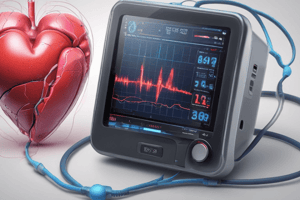Podcast
Questions and Answers
What is the primary purpose of Holter analysis?
What is the primary purpose of Holter analysis?
- To evaluate cholesterol levels
- To perform surgery on heart patients
- To assess heart rhythm abnormalities (correct)
- To replace traditional ECG tests
What type of data does a Holter monitor primarily record?
What type of data does a Holter monitor primarily record?
- Heart electrical activity (correct)
- Blood sugar levels
- Respiratory rate
- Body temperature
Which of the following is a limitation of Holter analysis?
Which of the following is a limitation of Holter analysis?
- It may miss arrhythmias occurring outside monitoring (correct)
- It provides real-time heart surgery data
- It captures all arrhythmias accurately
- It is easy to interpret without training
What type of symptoms may Holter analysis help evaluate?
What type of symptoms may Holter analysis help evaluate?
What is included in the output report of Holter analysis?
What is included in the output report of Holter analysis?
Flashcards are hidden until you start studying
Study Notes
Holter Analysis
-
Definition: Holter analysis refers to the interpretation of data obtained from a Holter monitor, a portable device used to continuously record heart activity (ECG) over 24 to 48 hours.
-
Purpose:
- Assess heart rhythm abnormalities (arrhythmias).
- Evaluate symptoms like palpitations, dizziness, or syncope.
- Monitor efficacy of cardiac medications.
- Identify silent ischemia or other cardiac events.
-
Procedure:
- The patient wears electrodes attached to the chest connected to the Holter monitor.
- The device records the heart's electrical activity during normal daily activities.
- Patients are usually instructed to keep a diary noting symptoms and activities.
-
Data Analysis:
- ECG strips are analyzed for:
- Rhythm changes (e.g., atrial fibrillation, ventricular tachycardia).
- Frequency and duration of arrhythmias.
- ST-segment changes indicating ischemia.
- Heart rate variability.
- ECG strips are analyzed for:
-
Output Report:
- Summary of recorded data (total beats, pauses, etc.).
- Identification of arrhythmias and their frequency.
- Correlation with patient-reported symptoms.
- Recommendations for further testing or treatment.
-
Limitations:
- May not capture all arrhythmias if they occur outside the monitoring period.
- Quality of data can be affected by electrode placement or patient activity.
- Requires careful interpretation by trained healthcare professionals.
-
Clinical Relevance:
- Provides valuable insights into cardiac health.
- Aids in diagnosing underlying heart conditions.
- Supports treatment decisions and management strategies.
Holter Analysis Overview
- Holter analysis interprets data from a Holter monitor, which records heart activity (ECG) continuously for 24 to 48 hours.
- Essential for assessing heart rhythm abnormalities (arrhythmias) and playing a crucial role in diagnosing various cardiac issues.
Purpose of Holter Monitoring
- Assesses arrhythmias to understand heart function better.
- Evaluates patient symptoms such as palpitations, dizziness, and syncope.
- Monitors the efficacy of cardiac medications over time.
- Helps identify silent ischemia and record any significant cardiac events.
Procedure for Holter Monitoring
- Patients wear electrodes on their chest linked to the Holter monitor.
- The device captures heart electrical activity while the patient engages in normal daily activities.
- Patients maintain a diary to log any symptoms or changes in activity levels during the monitoring period.
Data Analysis in Holter Monitoring
- ECG strips are meticulously analyzed for rhythm changes like atrial fibrillation and ventricular tachycardia.
- Collects data on the frequency and duration of any identified arrhythmias.
- Evaluates ST-segment changes that may suggest ischemia.
- Assesses heart rate variability to further understand heart health.
Output Report Features
- Provides a summary of recorded data, including total beats and pauses.
- Identifies specific arrhythmias and their frequency occurrences.
- Correlates the data with symptoms reported by the patient.
- Offers recommendations for further testing or treatment based on findings.
Limitations of Holter Analysis
- May miss intermittent arrhythmias that occur outside the monitoring period.
- Data quality can suffer from poor electrode placement or patient movements.
- Requires expertise for accurate interpretation by trained healthcare professionals.
Clinical Relevance of Holter Analysis
- Offers critical insights into a patient's cardiac health status.
- Aids in diagnosing underlying heart conditions effectively.
- Supports clinical decision-making regarding treatment and management strategies.
Studying That Suits You
Use AI to generate personalized quizzes and flashcards to suit your learning preferences.




